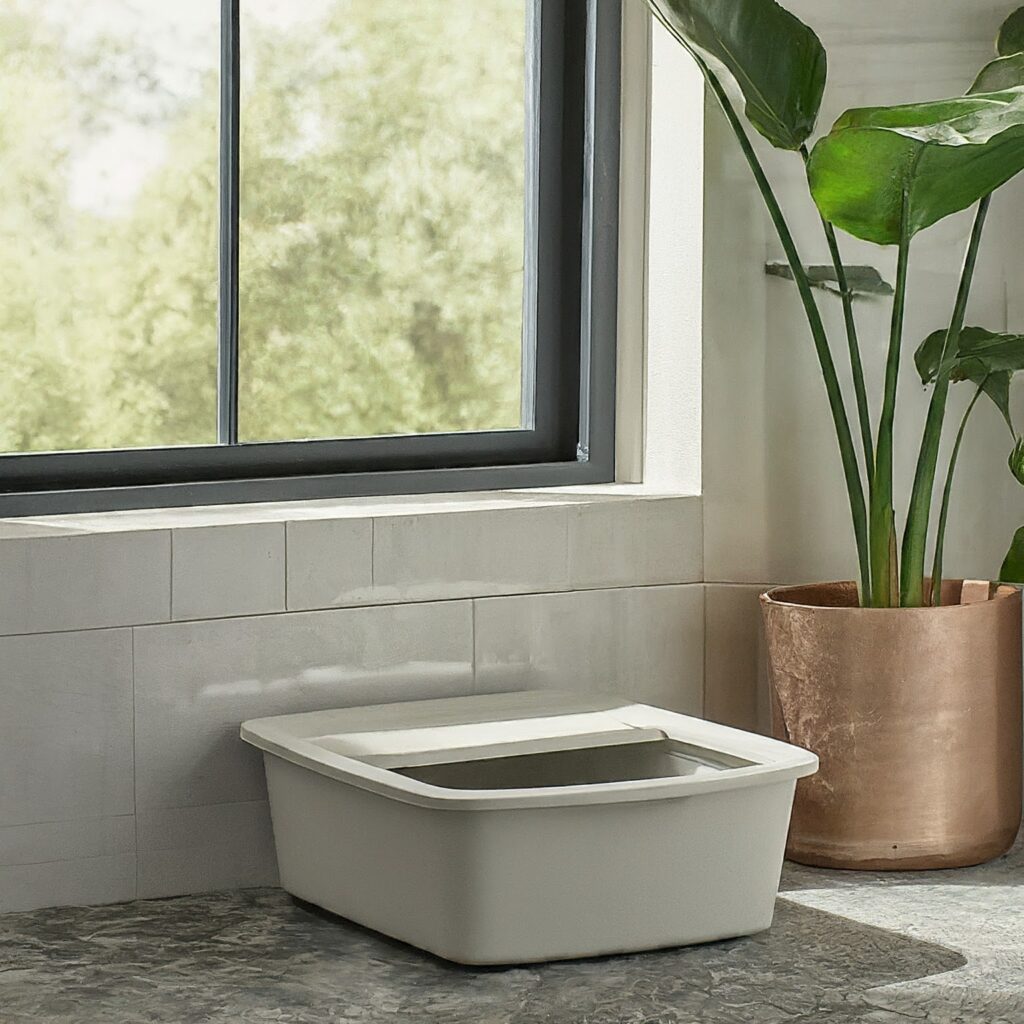Introduction:
How Many Litter Boxes Per Cat, Choosing the right number of litter boxes for your cat is essential for maintaining their hygiene and happiness. In this guide, we’ll explore the factors that influence the ideal number of litter boxes per cat and provide tips for creating a litter box setup that meets your cat’s needs.
Cats are cherished members of our families, and as responsible pet owners, it’s crucial to provide them with a comfortable and hygienic environment, including the right number of litter boxes. In this comprehensive guide, we’ll delve into the optimal litter box ratio and provide essential insights into ensuring your feline friend’s well-being and happiness.

Optimal Litter Box Ratio: How Many Litter Boxes Per Cat Do You Need?
Determining the ideal number of litter boxes per cat is crucial for maintaining their litter box habits and preventing stress or conflicts. The golden rule recommended by experts is to have one litter box per cat plus an additional box.
For example, if you have two cats, you should ideally have three litter boxes. This ensures that each cat has ample access to clean and private space for elimination, reducing the likelihood of territorial disputes or litter box aversion.
- The one-plus-one rule recommends one litter box per cat plus an additional box.
- This ensures each cat has adequate access to a clean and private space for elimination.
- Mimics cats’ natural instincts, promoting proper litter box habits and reducing stress.
- Provides flexibility in emergencies or changes in behavior.
- Crucial for creating a comfortable and hygienic environment supporting your cat’s well-being.

Calculating the Ideal Number: Litter Box Quantity Guidelines
While the one-plus-one rule serves as a useful guideline, several factors can influence the ideal number of litter boxes for your cats. Considerations such as the layout and size of your home, the number of cats, their ages, and any existing litter box issues should all be taken into account.
Observing your cats’ behaviors and preferences can help you determine if adjustments to the litter box setup are necessary.
Multi-Cat Household Essentials: Litter Box Allocation Strategies
In households with multiple cats, ensuring sufficient litter box access is paramount to maintaining harmony and preventing conflicts. Placing litter boxes in various locations throughout your home can help distribute resources evenly and provide each cat with options for elimination.
Additionally, having litter boxes on different levels of your home can accommodate cats with mobility issues and reduce the likelihood of territorial disputes.

Practical Solutions: Ensuring Sufficient Litter Box Access for Every Cat
Providing practical solutions to ensure sufficient litter box access for every cat is essential for promoting proper elimination habits. Regularly cleaning litter boxes and scooping waste at least once a day helps maintain cleanliness and encourages cats to use the litter boxes consistently.
Experimenting with different types of litter and litter box designs can also help cater to your cats’ preferences and promote a positive litter box experience.
Maximizing Comfort: Factors Influencing Litter Box Distribution
Factors such as the size and type of litter box, the location of the boxes, and the type of litter used can all influence your cats’ comfort and satisfaction with their litter boxes. Offering a variety of litter box options, including covered and uncovered boxes, can cater to your cats’ individual preferences and promote proper elimination behavior.
Additionally, ensuring that litter boxes are placed in quiet, low-traffic areas can help reduce stress and promote a sense of privacy for your cats.
Expert Advice: Understanding the Science Behind Litter Box Quantity
Seeking expert advice from veterinarians or animal behaviorists can provide valuable insights into understanding the science behind litter box quantity and ensuring the well-being of your cats.
These professionals can offer personalized recommendations based on your cats’ unique needs and circumstances, helping you create a litter box setup that promotes proper elimination habits and fosters a harmonious relationship between you and your feline companions.
Territorial Nature of Cats
Cats and Territory
Cats are territorial by nature. They associate spaces, including their litter boxes, with territory. Understanding this behavior is crucial to providing an environment where they feel secure and stress-free.
Impact on Litter Box Usage
The number of litter boxes directly influences how cats navigate their territories. Multiple boxes can help alleviate potential conflicts, ensuring each cat has its own designated space.
The Cleanliness Factor
Cat Grooming Habits
Cats are meticulous groomers, and this extends to their toileting habits. They prefer clean litter boxes and may refuse to use a dirty one. Regular cleaning is key to maintaining a positive relationship between your cat and its litter box.
Cleanliness and Litter Box Acceptance
A clean litter box not only promotes regular use but also prevents accidents. Cats are more likely to choose their designated space if it’s consistently clean and inviting.
Ideal Ratio of Litter Boxes
Single-Cat Household
In a single-cat household, having at least one litter box is a must. However, adding a second box provides your cat with options, reducing the likelihood of them refusing to use a dirty box.
Multiple-Cat Household
For homes with multiple cats, the guideline is one litter box per cat, plus an extra box. This ensures each cat has its own territory, minimizing territorial disputes and promoting a peaceful living environment.
Location Matters
Choosing the Right Spot
Select quiet and easily accessible areas for placing litter boxes. Avoid high-traffic spots, and ensure your cat feels secure when using the box.
Multi-Story Homes
In multi-story homes, having litter boxes on each level is advisable, especially if your cat has mobility issues. This prevents them from navigating stairs to find their designated space.
Litter Box Maintenance
Regular Scooping
Scoop litter boxes at least once a day to remove waste promptly. This not only keeps the box clean but also reduces the risk of your cat finding alternative spots in your home.
Monthly Deep Clean
Once a month, perform a deep cleaning of the litter boxes. Empty them completely and wash them with mild, unscented soap. This practice helps prevent odors and provides a fresh space for your cat.
Ensuring Accessibility
Making Litter Boxes Easily Accessible
Ensure your cat can access its litter box without obstacles. Accessibility is crucial, especially for older or differently-abled cats.
Avoiding High-Traffic Areas
Keep litter boxes away from high-traffic areas to minimize disturbances. Cats prefer a quiet and private space for their toileting needs.
The Psychology Behind Multiple Boxes
Reducing Stress
Multiple litter boxes reduce stress among cats by providing each with its own territory. This is particularly important in multi-cat households.
Preventing Territorial Disputes
Territorial disputes can lead to behavioral issues. Having enough litter boxes helps prevent conflicts and ensures a peaceful coexistence.
Benefits of Multiple Boxes
Promoting Regular Use
Multiple litter boxes encourage regular use, as cats have options to choose from. This is especially beneficial in preventing litter box aversion.
Avoiding Accidents
Accidents can occur if a cat feels its litter box is too dirty. Having multiple boxes decreases the likelihood of accidents and keeps your home clean.
Solving Common Problems
Refusal to Use a Dirty Box
If your cat refuses to use a dirty box, having multiple boxes allows for easy access to a clean one, reducing the chances of refusal.
Behavioral Issues
Territorial or behavioral issues can arise if a cat doesn’t have its designated space. Multiple litter boxes address these problems, promoting a healthier environment.
Cat-Friendly Litter Options
Considering Your Cat’s Preferences
Experiment with different litter materials to find what your cat prefers. Some cats have specific preferences, and finding the right litter can make a significant difference.
Experimenting with Different Materials
How Many Litter Boxes Per Cat, Explore various litter materials, from clumping to non-clumping, and choose the one that suits your cat’s comfort and your cleaning preferences.
Customizing for Senior Cats
Adjusting for Mobility
Senior cats may have mobility issues. Customize their litter box setup by placing boxes on one level and choosing low-entry options for easy access.
Special Considerations
Consider special needs or health conditions. Consult with your veterinarian for advice on the most suitable litter box setup for senior cats.
Introducing New Litter Boxes
Gradual Transition
When introducing new litter boxes, do so gradually. Allow your cat time to adjust, and monitor their reactions to ensure a smooth transition.
Monitoring Cat Reactions
Observe your cat’s reactions to the new litter boxes. If they show signs of discomfort or aversion, consider adjusting the setup to better suit their preferences.
Conclusion
Ensuring your cat’s comfort is paramount for fostering a harmonious and fulfilling relationship between you and your beloved feline friend. By delving deep into their behavior and providing an ample number of litter boxes, you pave the way for a happy coexistence where both you and your cat can thrive. Remember, a content cat not only brings joy to your home but also reflects the care and dedication of a conscientious owner. Prioritizing their needs is a testament to the love and commitment you share, resulting in a bond that enriches both of your lives immeasurably.
FAQs: How Many Litter Boxes Per Cat?
Q: 1 Are covered litter boxes better for cats?
A: Covered boxes provide privacy, but some cats may prefer open ones. Observe your cat’s preferences.
Q: 2 How often should I change the litter?
A: Daily scooping is crucial, but a complete litter change should occur at least once a month for optimal cleanliness.
Q: 3 Can I use human toilet training kits for cats?
A: While some owners have success, it’s essential to ensure your cat is comfortable with the transition.
Q: 4 What if my cat refuses to use any litter box?
A: Identify the cause, such as cleanliness or behavioral issues, and address them accordingly. Multiple boxes can often help.
Q: 5 Are automatic litter boxes worth it?
A: Automatic litter boxes can be convenient, but some cats may find them intimidating. Introduce them gradually and monitor your cat’s response.












Pingback: Why having more than one litter box is good for your cat's health - KLIGHT HOUSE